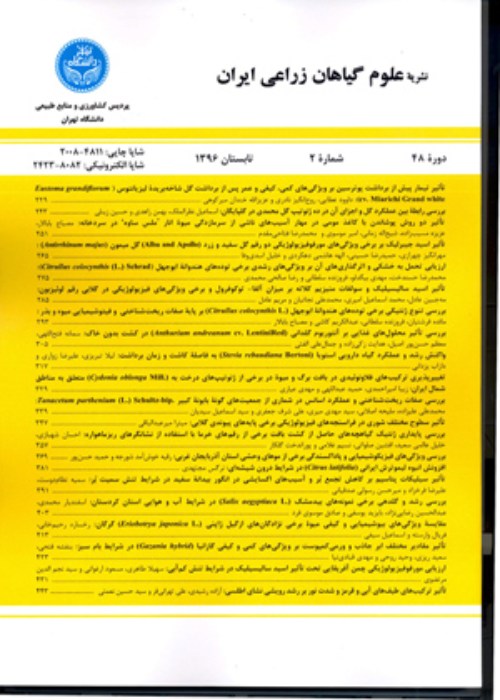Study of Changes of Cold-Induced Proteins during Transition of Vegetative to Reproductive Stages in Winter Wheat under Field Conditions
Author(s):
Abstract:
Phase transition from vegetative to reproductive growth is an important character for winter wheat under cold conditions because it decreases the ability of wheat plants to maintain frost tolerance. Reproductive development in winter wheat is triggered by fulfillment of vernalization requirements. This study was conducted to determine the inter-relationship between developmental stages and freezing tolerance. Using proteomic analysis, an investigation aimed at a better understanding of the proteins changes during the vegetative/reproductive phase transition was carried out in a hardy (Norstar) wheat cultivar under field conditions in the cold (Zanjan and Firoozkuh) and moderate (Karaj) regions of Iran. Proteins were extracted from the leaves, collected from plants during three different growth stages including T1: vegetative growth when plants increased their frost tolerance (23-Nov), T2: vernalization saturation point when plants acquired to maximum frost tolerance (21-Dec) and T3: after vegetative/reproductive phase transition and reduction in freeze tolerance (21-Feb). Change in protein expression was detected by two dimensional (2-D) gel electrophoresis. Approximately 400 protein spots were reproducibility separated and visualized on CBB-stained 2-D gels. Spot analysis showed that 307 proteins significantly changed during investigated times. Spot identification was performed by MALDI-TOF and ESI-MS/MS. Comparison of proteins changes among different locations exhibited significant variations. Comparing proteoms between Karaj and Zanjan during cold acclimation exhibited higher accumulation of cold-induced proteins in Zanjan. Proteoms comparison between Karaj and Firoozkooh detected higher accumulation of proteins involved in glycolysation. 22% of identified proteins were located in chloroplast which emphasize that this organelle has an important role during the cold acclimation and phase transition. The most changed proteins mainly participate in photosynthesis, glycolysis, protein folding, redox homeostasis, transcription, translation, amino acid biosynthesis, ATP synthesis and ion transport. Expression profile of some identified proteins such as cell division control protein, asparagine synthase, RuBisCO activase, actin, heat shock protein 70, cp31BHv, serpin, fructose-bisphosphate aldolase, MADS-box transcription factor 26 and Ps16 during the investigated stages were similar to LT tolerance trend. These proteins might work cooperatively to establish a new homeostasis under cold stress.
Keywords:
Language:
Persian
Published:
Iranian Journal of Field Crop Science, Volume:43 Issue: 1, 2012
Page:
93
magiran.com/p1017461
دانلود و مطالعه متن این مقاله با یکی از روشهای زیر امکان پذیر است:
اشتراک شخصی
با عضویت و پرداخت آنلاین حق اشتراک یکساله به مبلغ 1,390,000ريال میتوانید 70 عنوان مطلب دانلود کنید!
اشتراک سازمانی
به کتابخانه دانشگاه یا محل کار خود پیشنهاد کنید تا اشتراک سازمانی این پایگاه را برای دسترسی نامحدود همه کاربران به متن مطالب تهیه نمایند!
توجه!
- حق عضویت دریافتی صرف حمایت از نشریات عضو و نگهداری، تکمیل و توسعه مگیران میشود.
- پرداخت حق اشتراک و دانلود مقالات اجازه بازنشر آن در سایر رسانههای چاپی و دیجیتال را به کاربر نمیدهد.
In order to view content subscription is required
Personal subscription
Subscribe magiran.com for 70 € euros via PayPal and download 70 articles during a year.
Organization subscription
Please contact us to subscribe your university or library for unlimited access!


